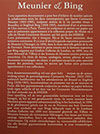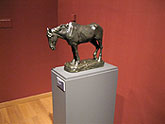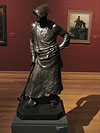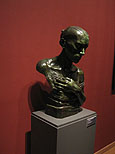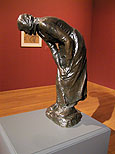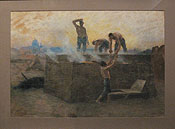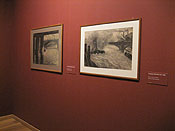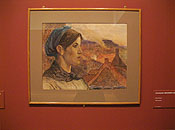X
Please wait for the PDF.
The browser will either open the file, download it, or display a dialog.
The browser will either open the file, download it, or display a dialog.
|
Meunier and Bing |
||||||||
|
One dividend to a large-scale exhibition covering a wide topic and, as in case of L'Art Nouveau: La Maison Bing, a large number of artists, is the possibility of highlighting the career and work of one of the artists represented in the primary exhibition in a subsidiary, smaller show. In the case of L'Art Nouveau: La Maison Bing, the museum staff of the originating Van Gogh Museum in Amsterdam (2004-05) decided to focus on Vincent van Gogh's interest in Japanese art by showing a wide range of his Japanese prints, most of which came from Parisian entrepreneur and art dealer Siegfried Bing (1838-1905). In Brussels, where L'Art Nouveau: La Maison Bing was on view from March 17 to July 23, 2006, at the Musées royaux des Beaux-Arts, curators chose to focus on Constantin Meunier (1831-1905), whose connections with Bing were recalled not only in the large Art Nouveau exhibition, but also in a detailed show on display in the same venue. The impact of this smaller, documentary exhibition—a focused show done in depth—was not only timely, but also excellent in every aspect of its organization and installation. | |||||||
| Taking as its premise that Constantin Meunier's career was given a significant boost by the support he received in Paris when Bing held two separate retrospectives of Meunier's work in his gallery at 22 rue de Provence (one in March 1896, the other in December 1899), the show in Brussels came upon an undeniable raison d'être. It suggested the way in which Bing continually supported Meunier's work not only by including him in his First and Second Salon of Art Nouveau (1895-96), but also in two shows where a wide range of the artist's works were included. This latter Meunier exhibition was also held at the progressive Grafton Galleries in London, where Meunier's work was shown alongside examples of glass by the American designer Louis Comfort Tiffany, and pieces that had been created by designers working directly for Bing out of his Paris workshops. By focusing on these significant shows, the organizers in Brussels were careful to reconstruct the choice of works by Meunier that were originally on display, while also adding documentary materials that reinforced the value of the shows in Meunier's career. Even though, at first glance, Meunier's realistic renderings of the life in the mines can seem antithetical to art nouveau, Bing saw beyond the individual seemingly realistic renditions and understood that what Meunier achieved was a sweeping, almost symbolic, vision of the condition of the miner. This was a true art nouveau, in the sense that the artist was capable of transcending common artistic renditions to achieve a universal language covering all tendencies that were trying to do something that was novel. | ||||||||
| The Theme of the Worker From the beginning, the Meunier exhibition was carefully presented and explained through the use of wall labels that revealed the reasons for the show. These texts, in French and Flemish, were situated in key areas so that visitors could easily understand the show's rationale (fig. 1). The wall texts were reinforced by a four-page flyer that also discussed the reasons for the show, providing visitors with something that was both free and which could be taken away from the exhibition itself. While well conceived, the wall labels didn't overwhelm the works, but gave the viewer enough information to make the show not only visually pleasurable, but also a learning experience. Located near the entrance to the show was a case that contained letters between Bing and Meunier, and even more significant, a visitor's comment book with statements made at the Meunier show at the L'Art Nouveau gallery in 1896. This document, recently found in the archives of the Meunier museum in Brussels, had not been known to exist; in the future it will provide a rich commentary from those who actually visited the exhibition at the time providing evidence of who some of the visitors were and what they might have been thinking about as they visited the exhibition. |
||||||||
| Close to this material, and as an example of how Meunier developed his realism, was a bronze of a horse weary from his daily and unending labor, which was to haul material in the mines in the Borinage region (fig. 2). Since this visual reference was crucial to an understanding of Meunier's work, the bedraggled nature of the horse provided evidence for the way in which this theme was identified as one of the critical undercurrents of Meunier's work in 1896 and in the present show in Belgium. It was a point that could not be missed by anyone. Meunier was adept at showing sympathy for the beasts of burden as his works drew telling parallels between the condition of the horse and the true state of the worker whom he idolized. | ||||||||
| Near the horse, and in the middle of the room itself, was a large bronze representing one of the mineworkers: le marteleur (the hammerman). Posed with one hand on a hip, as he holds the tool of his labor in the other, this worker appeared larger than life (fig. 3). While the piece was a small version of the work, it retained all the monumentality of the original. Meunier was able to convey in both the small and large version of the sculpture, through the attitude and pose of the model, that the miner was a hero—a crucial figure in the industrial revolution. By situating the worker in such a central position in the show, curator Murielle Alpen did much to remove the varied political interpretations of Meunier's imagery in order to center on how the artist worked to create a purely realistic quality free from a solely ideological discourse. In situating other examples of Meunier's sculpture in the exhibition itself—those of women (fig. 4) or the wives of miners (fig. 5)—the compassion that Meunier evoked for oppressed laborers and their families emerged even further. It was an effective way of demonstrating the power and majesty of these pieces similar to those actually shown by Bing in 1896 and 1899. | ||||||||
| The Diversity of Images It was remarkable that a show as small as this one so ably suggests the range of Meunier's creativity and his varied use of media. Aside from the bronzes noted above, the exhibition made ample use of drawings, pastels, and some paintings to help situate Meunier's abundant productivity. The pastels that focused on a few workers (fig. 6) silhouetted against the sky, for example, clearly demonstrate Meunier's prodigious interest in showing the effort of his muscular heroes. Bing's awareness of Meunier, aided by the fact that he had come to Brussels to study pieces in situ, was significantly reinforced by the way in which Meunier's work was written about at the time since he was hailed as being committed to the most progressive tendencies of the time. |
||||||||
| Bing must have also maintained a strong realist bias in the works he exhibited by painters and sculptors. This was partially reinforced by the kinds of works that he collected for himself and which he undoubtedly exhibited in his home on rue Vézelay in Paris. But Bing, as we well know, was firmly dedicated to promoting L'Art Nouveau as an international phenomenon, and with Meunier he had a perfect artist to make his point. The works that Bing exhibited in 1896 were referenced in the Brussels show: views of industrial locations, landscapes of the urban environment (fig. 7) and close-up studies of women, also workers in the mines, visualized by the artist as colleagues in the industrialized effort (fig. 8). The works exhibited in Brussels were the specific works shown by Bing, in either 1896 or 1899. Working with a very modest budget, the pieces were selected from the collections of the Musées royaux des Beaux-Arts (Brussels) and the Constantin Meunier Museum (Brussels) suggesting the atmosphere of the original exhibitions. It was a remarkable way to convey the flavor and the fervor for Bing's dedicated support of this artist. | ||||||||
| The Contribution While not all visitors to the L'Art Nouveau: La Maison Bing exhibition knew about this small exhibition, nor was it easy to locate in the museum itself (it was shown in a small gallery upstairs away from the large exhibition), those that did find the show were amply rewarded. Here was the perfect blending of archeological reconstruction, a sensitive eye toward the work of an artist, and a dedicated way of showing why an artist often overlooked in the past was worth renewed consideration. At the same time, by referencing the ways in which Siegfried Bing had paved the way for the international reputation of Meunier in the past, the show was a superb addition that helped further contextualize the ways in which Belgian art was made more cosmopolitan through the actions of an engaged entrepreneurial patron from another country. Meunier is only one of the many Belgian artists that Bing included in his Salons de l'Art Nouveau and sold in his gallery, but as the only one who received such concerted support in separate exhibitions, he was the likeliest choice for added exposure. |
||||||||
|
Gabriel P. Weisberg |
||||||||


